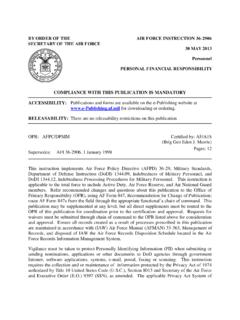Transcription of BY ORDER OF THE AIR FORCE INSTRUCTION 36 …
1 BY ORDER OF THE SECRETARY OF THE AIR FORCE AIR FORCE INSTRUCTION 36-3103 18 MAY 2016 Personnel IDENTIFICATION TAGS COMPLIANCE WITH THIS PUBLICATION IS MANDATORY ACCESSIBILITY: Publications and forms are available for downloading or ordering on the e-publishing website at RELEASABILITY: There are no releasability restrictions on this publication. OPR: AF/A1XO Supersedes: AFI 36-3103, 25 Jan 2012 Certified by: AF/A1 (Robert E. Corsi) Pages: 8 This INSTRUCTION outlines when and how identification (ID) tags are issued to Air FORCE service members and when they are to be worn (or in the individual s possession). This INSTRUCTION sets forth identification tag policy for Regular Air FORCE (RegAF), Air FORCE Reserve (AFR) and Air National Guard (ANG) personnel. In collaboration with the Chief of Air FORCE Reserve (AF/RE) and the Director of the Air National Guard (NGB/CF), the Deputy Chief of Staff for Manpower, Personnel and Services (AF/A1) develops personnel policy for ID tags.
2 This publication may be supplemented at any level; all MAJCOM supplements must be approved by the Human Resource Management Strategic Board (HSB) prior to certification and approval. It implements Air FORCE Policy Directive (AFPD) 36-31, Personnel Affairs. The authorities to waive wing/unit level requirements in this publication are identified with a Tier ( T-0, T-1, T-2, T-3 ) number following the compliance statement. See AFI 33-360, Publications and Forms Management, Table for a description of the authorities associated with the Tier numbers. Send comments and suggested improvements on AF Form 847, Recommendation for Change of Publication, through appropriate channels, to the FORCE Support Organization and Readiness Division, AF/A1XO, 1040 Air FORCE Pentagon, Washington, DC, 20330-1040. Process supplements that affect any military personnel function in accordance with (IAW) AFI 33-360, Publications and Forms Management.
3 This INSTRUCTION requires collecting or maintaining information protected by the Privacy Act of 1974, System of Records Notices (SORN) F036 AF PC Q, Personnel Data System (PDS) apply and are available at: Ensure that all records created as a result of processes prescribed in this publication are maintained IAW Air FORCE Manual (AFMAN) 33-363, Management of Records, and disposed of IAW the Air FORCE Records Disposition Schedule (RDS) in the Air FORCE Records Information Management System (AFRIMS). 2 AFI36-3103 18 MAY 2016 SUMMARY OF CHANGES This document has been substantially revised and must be completely reviewed. Major changes include AF/A1X and AF/Surgeon General (SG)3/5 responsibilities, Red Medical Alert Identification Tag procedures, updated office symbols and added tier waiver authority information.
4 1. Responsibilities. Director, AF/SG3/5 will: Subject to availability of Congressional appropriations, fund the purchase of Red Medical Alert ID tags for all Air FORCE Medical Service (AFMS) facilities. Direct the Medical Treatment Facilities (MTF), Reserve Medical Units (RMUs), RegAF, Air FORCE Reserve Command (AFRC), and Air National Guard (ANG) Aeromedical Evacuation Squadrons (AESs), and Guard Medical Units (GMUs) that already possess an ID Tag embosser to continue to follow established local procedures for producing Red Medical Alert ID tags and subject to availability of Congressional appropriations, continue with the funding, maintenance, and repairs of that device. Ensure medical staff will adhere to DoD , DoD Health Information Privacy Regulation dated January 2003, Section Develop a process and standardized form for all MTFs to ensure the proper information is placed on the Red Medical Alert ID tag.
5 Director, AF/A1X will: Direct FORCE Support Squadron (FSS) Military Personnel Section (MPS), and Installation Personnel Readiness (IPR) office to continue to follow established procedures for producing ID tags IAW this INSTRUCTION . In addition, FSS/MPS IPRs will continue to fund, maintain and repair ID embosser machines, subject to availability of Congressional appropriations. Provide policy on ID tags to include Red Medical Alert ID tags. Policy will be coordinated with AF/SG3/5 to ensure policy and procedures continue to adhere to governing guidance. Commander of Wing/Installation FSS/MPS will: Develop a Memorandum of Understanding (MOU) with the installation Medical Commander to outline processes for producing the Red Medical Alert ID tag, the frequency of production and distribution to members readiness folders.
6 (T-1) Ensure the IPR office has the funding to maintain, repair and replace as needed subject to availability of Congressional appropriations, the ID Tag embosser at the IPR office. (T-1) Ensure IPRs provide training to designated MTF personnel on the use of the ID Tag embosser located at the IPR office. (T-1) Ensure IPRs provide access to the ID Tag embosser at the IPR for designated medical personnel. (T-1) AFI36-3103 18 MAY 2016 3 Commanders of Local MTFs, Reserve Medical Units (RMUs), RegAF, AFRC, and ANG Aeromedical Evacuation Squadrons (AESs), and Guard Medical Units (GMUs) will: Establish guidance based on issuance (policy)/directive for Red Medical Alert ID tags. (T-1) Develop a MOU with the installation FORCE Support Squadron Commander and MPS Commander to outline processes for producing the Red Medical Alert ID tag, the frequency of production and distribution to members readiness folders.
7 (T-1) Designate a medical POC ( medical readiness) who will be responsible for making the Red Medical Alert ID Tags, ensure the correct medical information is printed on the tags ( medical abbreviations), Aeromedical Services Information Management Systems (ASIMS) is updated and the Red Medical Alert Tags are taken back to the MTF for distribution to the proper units. (T-1) Develop a process for the medical Unit Deployment Manager (UDM) to get the Red Medical Alert ID tags to other base organization UDMs. (T-1) Geographically Separated Units (GSU s) will contact the nearest Air FORCE Medical Treatment Facility to obtain their Medical Alert ID tags. (T-1) Unit Commanders will: Ensure one set of ID tags are issued to each individual. (T-1) Ensure each individual understands when and how ID tags are worn. (T-1) Inspect the accuracy of ID tags annually to ensure information contained on them is accurate and complete.
8 (T-1) Unit Deployment Manager will: Retain ID tags for individuals assigned to deployment positions as required by local policy. (T-1) Optionally, keep ID tags in a central location within the assigned unit when not in use by the individual. Ensure procedures are in place to check out ID tags when needed by the individual. (T-1) MPS Commanders will: Ensure procedures are in place for preparation and issuance of ID tags as required by this INSTRUCTION . (T-1) Ensure procedures are established to dispose of improperly prepared or surrendered ID tags in the most economical method locally available according to AFI 33-332, Privacy ActictectProgram. (T-1) Airmen will: Wear or have ID tags in their possession while performing duty as an aircrew member. (T-1) Wear ID tags while participating in a contingency or contingency exercise.
9 (T-1) 4 AFI36-3103 18 MAY 2016 A contingency is defined as an emergency involving military forces caused by natural disasters, terrorists, subversives, or by required military operations. This includes any duty in a declared war, hostile fire, imminent danger zone, peacekeeping or humanitarian operation and rotational Temporary Duty (TDY) operations. A contingency exercise is defined as a military maneuver or simulated wartime operation involving planning, preparation, and execution. It is carried out for the purpose of training and evaluation. It may be a multinational, joint, or single-Service exercise, depending on participating organizations. Wear or have ID tags in their possession when otherwise directed by their supervisor or commander. 2. Issuance of ID Tags. Issue ID tags: Upon entrance into RegAF or Air Reserve Component.
10 When information contained on ID tag is invalid or ID tags are missing. MTFs issue Red Medical Alert tags. (T-1) Upon notification of deployment for civilian personnel. An ID tag set is defined as two tags, one long-length neck chain, and one short-length neck chain. ID tags and chains can be ordered through Base Supply using the following National Stock Numbers (NSN): ID tag - NSN 8465-00-242-4804. (100 tags per box) Chain necklace - NSN 8465-00-261-6629. (100 sets per box, one long and one short neck chain) ID Tag Content. Each tag has a capacity for five lines of type, 18 spaces to the line, and is embossed by a machine provided for that purpose. The following are the contents of each line: First line - Name (last name, first name, and middle initial). If entire name does not fit on first line, emboss the last name only on the first line.











